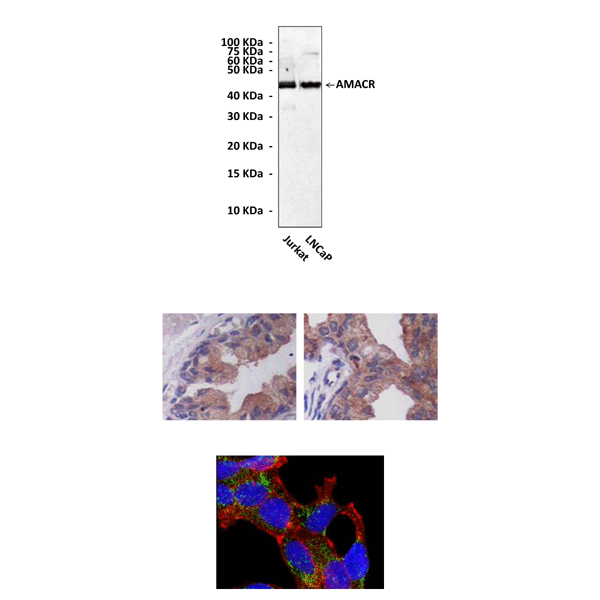Anti-AMACR: Mouse alpha-Methylacyl-CoA Racemase Antibody |
 |
BACKGROUND AMACR, also known as P504S, is a mitochondrial and peroxisomal enzyme that catalyzes the racemization of alpha-methyl, branched carboxylic coenzyme A thioesters and is Responsible for the conversion of pristanoyl-CoA and C27-bile acyl-CoAs to their (S)-stereoisomers. The conversion to the (S)-stereoisomers is necessary for degradation of these substrates by peroxisomal beta-oxidation. Thus, it plays a crucial role in the beta-oxidation of bile acid intermediates, dietary branched-chain fatty acids, and fatty acid derivatives.1 Mutations in this gene may be associated with adult-onset sensorimotor neuropathy, pigmentary retinopathy, and adrenomyeloneuropathy due to defects in bile acid synthesis.2 Alternatively spliced transcript variants have been described. Recent studies showed that AMACR is overexpressed in a variety of neoplasms, such as prostate and colon cancer. AMACR overexpression in human solid tumors is a potential target for cancer treatment.3
REFERENCES
1. Evans, A.J.: J. Clin. Pathol. 56:892-897, 2003
2. Ferdinandusse, S. et al: Nature Genet. 24:188-191, 2000
3. Truong, C.D. et al: Int. J. Clin. Exp. Pathol. 1:518-523, 2008
2. Ferdinandusse, S. et al: Nature Genet. 24:188-191, 2000
3. Truong, C.D. et al: Int. J. Clin. Exp. Pathol. 1:518-523, 2008
Products are for research use only. They are not intended for human, animal, or diagnostic applications.
Параметры
Cat.No.: | CP10009 |
Antigen: | Recombinant human AMACR protein fragment expressed in E. coli. |
Isotype: | Mouse IgG2b |
Species & predicted species cross- reactivity ( ): | Human, Mouse |
Applications & Suggested starting dilutions:* | WB 1:500 - 1:2000 IP 1:50 - 1:100 IHC 1:200 - 1:1000 ICC 1:200 - 1:1000 FACS n/d |
Predicted Molecular Weight of protein: | 43 kDa |
Specificity/Sensitivity: | Detects endogenous levels of AMACR proteins in normal cell lysates without cross-reactivity with other related proteins. |
Storage: | Store at -20°C, 4°C for frequent use. Avoid repeated freeze-thaw cycles. |
*Optimal working dilutions must be determined by end user.
Документы
Информация представлена исключительно в ознакомительных целях и ни при каких условиях не является публичной офертой








